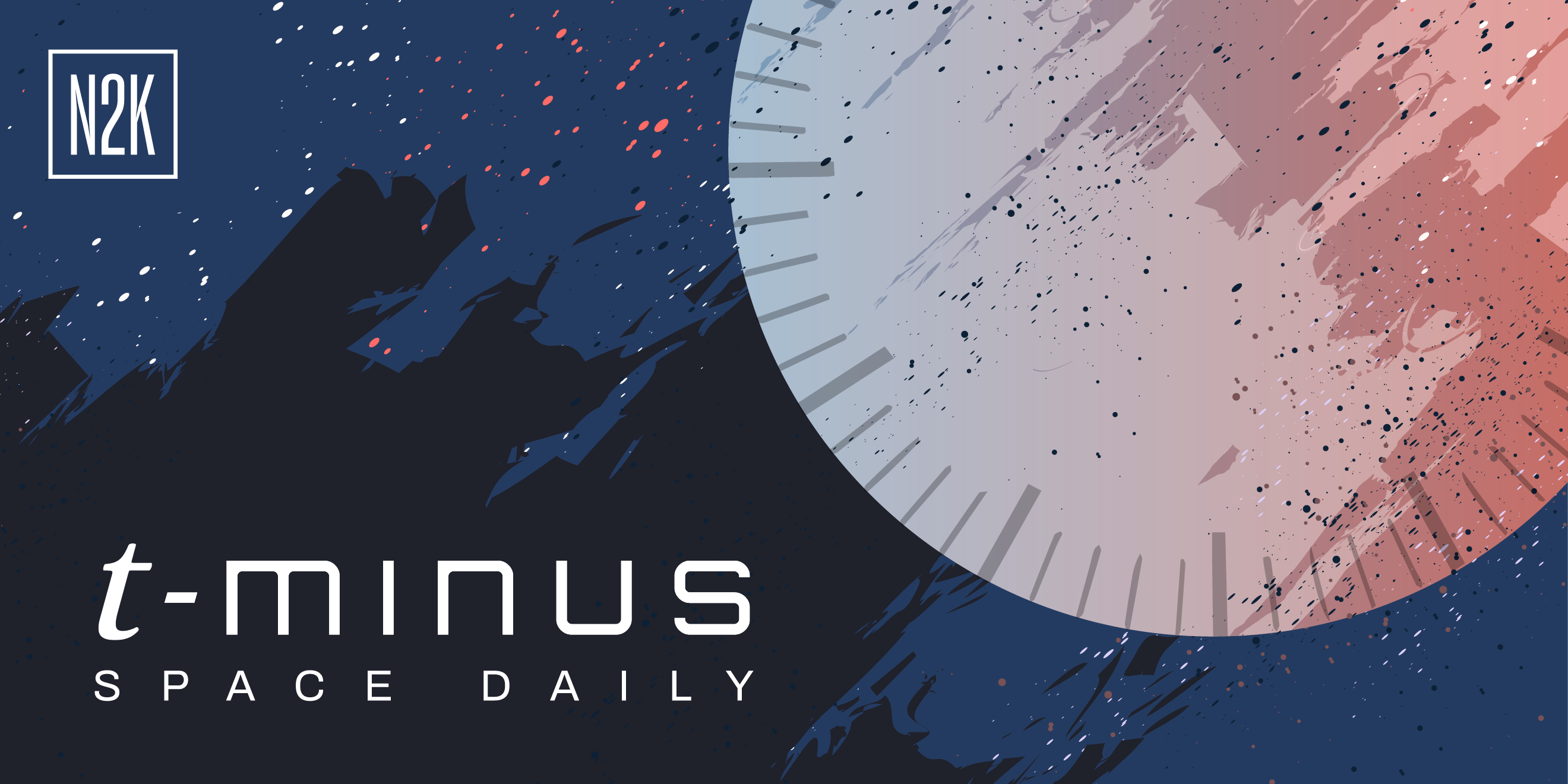[MUSIC PLAYING] Today is September 10, 2025. I'm Maria Varmazis, and this is T-minus. [MUSIC PLAYING] T-minus. 20 seconds to LOS, T-dris. Open aboard. [INAUDIBLE] [MUSIC PLAYING] [INAUDIBLE] [INAUDIBLE] [MUSIC PLAYING] Five. SpaceX performed a static test fire of the super heavy booster slated for Starship's 11th launch. Four. The Roscosmos Progress 91 spacecraft has undocked from the ISS, giving the way for two resupply missions due to be launched this week. Three. The Indian Space Research Organization says it is working on Chandrayon-4 and Chandrayon-5 and plans to have a completed module of their space station in orbit by 2035. Two. Reorbit has closed a 45 million Euro Series A funding round. One. Space X launches the Space Development Agency's first Tronch 1 mission to Leo. [MUSIC PLAYING] Happy Wednesday, everybody. Thank you for joining me today. Let's dive in, shall we? It was a bit of a cloudy start at Vandenberg Space Force Base in California, that didn't prevent the launch of the Space Development Agency's Tronch 1 mission. Twenty-one of the 154 satellites that will make up the first layer of the SDA's proliferated Warfighter Space Architecture, or PWSA, are now in space. They're expected to go through a few months of tests before they start providing operational value. The satellites launched will support elements that provide global military tactical communication and missile warning indication and tracking capabilities. The PWSA Tronch 1 is enabled by a team of multiple vendors to deliver both space and ground segments. They are the first spacecraft that will eventually make up a constellation of hundreds of optically linked small satellites in Leo. The SDA plans to launch its first Tronch 1 missile tracking satellites early next year, which will be key to the Pentagon's broader Golden Dome Initiative for tracking and defending against all kinds of missile threats. The Space Development Agency is targeting its next launch of Tronch 1 vehicles in the second week of October, part of a regular monthly cadence. Tronch 1 is meant to include six launches of data transport satellites and four missile warning satellites. All of the launches at this point are planned from Vandenberg. For our next story now, Reorbit has closed a 45 million Euro Series A funding round. It is the largest all equity series A round in Finland and one of the most significant deals overall in the European space and defense sector. The startup manufactures satellites and connected systems that provide nations with independent communications, intelligence capabilities, and full command of critical assets. Its systems serve both defense and civilian applications, enabling national resilience, autonomy, and control. Reorbit is positioning itself as an affordable alternative to SpaceX's Starlink, but unlike Starlink's business model, Reorbit wants its clients to have full ownership and sovereignty over their satellites and communications. The company says that it has closed numerous contracts and is experiencing increased demand from Asia, the Middle East, and Europe. This new funding will expand its manufacturing capacity, advance proprietary technologies, and grow its operations. Additionally, Reorbit says that it plans to open local satellite centers in several countries during the next 12 months. ISRO, or the Indian Space Research Organization, says it is working on the Chandrayaan-4 and Chandrayaan-5, and it plans to have a completed module of their space station in orbit by 2035. ISRO Chairman V. Narayanan told media that they are going to have an uncrewed mission this year, a crewed mission in the first quarter of 2027, and the first complete module of the Baratia-Antrix Station on orbit by 2028. ISRO is truly stuffing up their space programs right now, and they say that the number of satellites that they're going to place in orbit will also be around three times the present numbers. They're working on also improving the payload capacity of the Mark III launcher from 4,000 kilos to 5,100 kilos, which they say they will do without increasing any costs. We'd love to hear about their ambitious plans and do wish them the absolute best of luck with their timelines. It's a big time of change right now on the International Space Station, as the Orbiting Lab makes way for two new vehicle arrivals this week. The unpiloted Roscosmos Progress 91 spacecraft, undocked from the ISS last night, the vacant port now awaits the arrival of the Progress 93 cargo craft, which is set to launch from Kazakhstan on Thursday morning. The new Progress will be packed with 2.8 tons of cargo, and is set to dock to the Zvezda module on Saturday, following its automated approach and rendezvous maneuvers. Then, on Sunday, Northrop Grumman's expanded Cygnus XL cargo craft will launch atop a SpaceX Falcon 9 rocket. Cygnus XL will orbit the Earth for two and a half days before catching up to the orbital outpost. NASA Flight Engineers Johnny Kim and Zena Cardman will be at the controls of the Canadarm 2 robotic arm, ready to capture the Cygnus XL when it reaches a point about 10 meters away from the space station. And we will bring you more about the science that's heading up to the space station on our monthly catch up with the ISS National Lab on Monday Show. And can you believe that it has already been two weeks since the last test of SpaceX's Starship? Indeed, it seems like there's no rest for the SpaceX team, as they are already preparing for the next launch of Starship. SpaceX performed a static test fire of the Super Heavy booster, which is slated for Starship's 11th launch over the weekend. The booster B-15 fired its 33 Raptor engines for about 10 seconds on Sunday, and SpaceX shared the videos on their X-Profile. Boosters are typically test fired in the days and weeks leading up to the launches, and are part of final assessments to ensure vehicle safety ahead of liftoff. This test signals a quick turnaround for SpaceX as it prepares Starship for Flight Test 11. And if that's not enough for you on this Wednesday, N2K Senior Producer Alice Carruth joins us now with the other stories that are making Space News today. Alice, what have you got for us? There's a few extra links in today's Selected Reading section for you to read at your leisure, NASA's PXT Space Communication demo has started commissioning, and staying with the US Space Agency, we've included more details on their AI prediction models for solar events. ISI has released a new Intelligence Reconnaissance and Surveillance Cell, and Solid Rocket Motor Company Crossbow has signed a Memorandum of Understanding with Aeon. And I have a story on how you can get involved in the Artemis II mission coming up, yes for real, but before that, a reminder that the links to all of the stories mentioned in today's episode are in our show notes, and are also included on our website, which is space.n2k.com. Just click on today's episode title for more. Hey T-minus crew, if you find our podcast useful, you could do us a favor and share a 5-star rating and short review in your favorite podcast app. That will help other space professionals like you to find our show and join the T-minus crew. Thank you so much for your support everybody, we really appreciate it. [Music] We will be right back. [Music] Welcome back. If you'd like to be a tiny little part of the Artemis II mission, NASA is printing boarding passes right now. I always like it when missions do little things like this. You can send your name as part of Artemis II right now. Just submit your name on a website that NASA has spun up for just this purpose, and we'll have a link for you in the show notes of course. And it's called simply send your name with Artemis II. All of the names submitted will be loaded onto an SD card, and that card will fly on the Orion capsule. So your name and plain text loaded into a digital file put on a tiny storage device will fly around the moon. But that's mouthful, so let's just say that you can send your name, because it's true, technically. And you do get a little memento of all this too, as NASA's website then generates a little keepsake boarding pass for you. Just to print out, you know, do it yourself. It's something nice to look at while Artemis II and the crew do their lunar loop next year, and then you can look up at the moon holding onto that little boarding pass of yours in hand and say, "In a way, I'm up there with them." And that's T-minus, brought to you by N2K Cyberwire. What do you think about T-minus face daily? Please take a few minutes to share your thoughts with us by completing our brief listener survey, link in the show notes. Thank you for helping us continue to improve our show. We are proud that N2K Cyberwire is part of the daily routine of the most influential leaders and operators in the public and private sector, from the Fortune 500 to many of the world's preeminent intelligence and law enforcement agencies. N2K helps space and cybersecurity professionals grow, learn, and stay informed. As the nexus for discovery and connection, we bring you the people, the technology, and the ideas, shaping the future of secure innovation. Learn how at N2K.com. N2K Senior Producer is Alice Carruth. Our producer is Liz Stokes. We are mixed by Elliott Peltzman and Tre Hester, with original music by Elliot Peltzman. Our executive producer is Jennifer Eiben. Peter Kilpie is our publisher, and I am your host, Maria Varmazis. Thank you for listening. We'll see you tomorrow. [Music] T-minus. [Music] [BLANK_AUDIO]









